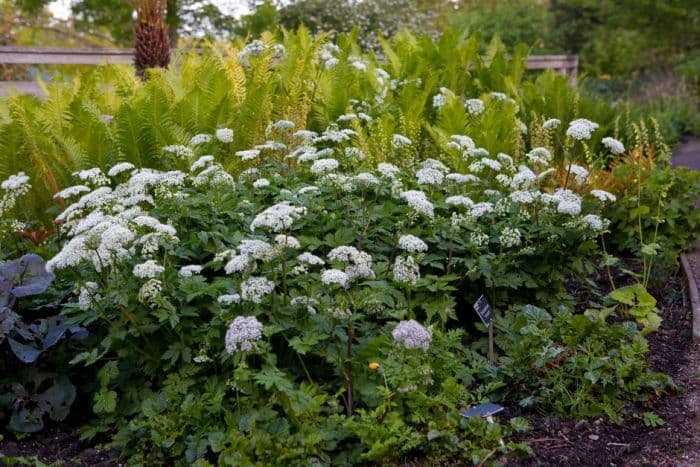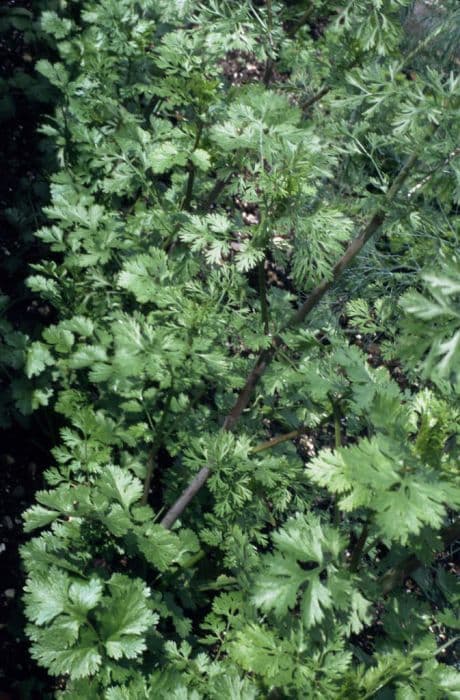Hairy Chervil Chaerophyllum hirsutum

ABOUT
Chaerophyllum hirsutum, commonly known as hairy chervil, is a flowering plant that features a soft, hairy texture with lush green leaves. These leaves are divided, resembling feathers with their intricate segments, and are arranged in a rosette pattern at the base. The leaf edges are gently serrated, giving them a subtle, saw-like appearance. As the plant matures, it produces tall, hollow, and grooved stems that bear more leaves and branch out to support umbrella-like clusters of small, white flowers. The arrangement of flowers in each cluster is akin to the spokes of an umbrella, creating a delicate, lacey canopy. The overall plant exhibits a fresh, deep green coloration, with the hairy surface of both the stems and leaves providing a unique, velvety texture.
About this plant
 Names
NamesFamily
Apiaceae
Synonyms
Hairy Chervil, Rough Chervil
Common names
Chaerophyllum hirsutum
 Characteristics
CharacteristicsLife cycle
Biennials
Foliage type
Deciduous
Color of leaves
Green
Flower color
White
Height
2-3 feet (60-91 cm)
Spread
1-2 feet (30-60 cm)
Plant type
Herb
Hardiness zones
5
Native area
Europe
Benefits
 General Benefits
General Benefits- Culinary Uses: Chaerophyllum hirsutum, commonly known as Hairy Chervil, can be used as a flavoring herb in a variety of culinary dishes, adding a unique taste to salads, soups, and sauces.
- Ecological Support: The flowers of the Hairy Chervil can attract beneficial insects, such as pollinators, which are essential for the pollination of many plants in an ecosystem.
- Soil Enrichment: Like other green plants, Hairy Chervil can contribute to soil health by adding organic matter as it decomposes, improving soil structure and fertility.
- Habitat Creation: The plant can provide cover and habitat for small wildlife, which is important for maintaining biodiversity in a garden or natural area.
- Aesthetic Appeal: With its delicate leaves and subtle flowers, Hairy Chervil can add visual interest and natural beauty to gardens and green spaces.
- Educational Value: Hairy Chervil can be used in educational contexts, providing a natural example for teaching about plant life cycles, ecology, and botany.
 Medical Properties
Medical Properties- This plant is not used for medical purposes.
 Air-purifying Qualities
Air-purifying QualitiesThis plant is not specifically known for air purifying qualities.
 Other Uses
Other Uses- Chaerophyllum hirsutum, also known as hairy chervil, can be used as a natural plant dye, producing colors ranging from soft yellows to deep greens depending on mordants used.
- The stems and fibrous parts of hairy chervil may be utilized in papermaking, contributing to a unique texture and finish in handmade paper products.
- When dried and crushed, the leaves can act as a natural insect repellent due to their aromatic properties, potentially warding off certain insects from gardens or pantries.
- The seeds of hairy chervil can be used in potpourri mixtures, adding a subtle fragrance and texture to the mix.
- As an aromatic herb, it could be included in drawer sachets to impart a pleasant smell to clothes and linen while deterring moths.
- Hairy chervil can serve as a green manure or cover crop, enhancing soil fertility and structure when chopped and mixed into the soil.
- The plant can be used in floral arrangements, particularly wildflower bouquets, for its delicate and feathery appearance.
- When composted, hairy chervil adds nutrient diversity to the compost pile due to its unique nutritional content.
- The plant can be part of a natural dye garden, serving as an educational example of historical dyeing techniques and the sources of natural dyes.
- Its fresh or dried leaves can subtly flavor artisanal cheeses when wrapped around them during the aging process.
Interesting Facts
 Feng Shui
Feng ShuiThe plant hairy chervil is not used in Feng Shui practice.
 Zodiac Sign Compitability
Zodiac Sign CompitabilityThe plant hairy chervil is not used in astrology practice.
 Plant Symbolism
Plant Symbolism- Invisibility: Chaerophyllum hirsutum, commonly known as Hairy Chervil, is not widely known for any particular symbolism. However, due to its less conspicuous nature in the plant world, it might be seen as a symbol of invisibility or being overlooked.
 Water
WaterFor the Hairy Chervil, commonly known as Chaerophyllum hirsutum, it is essential to maintain consistently moist soil, especially during its active growth in spring and early summer. Water the plant thoroughly when the top inch of soil feels dry to the touch. This typically means watering once or twice a week, but frequency may need to increase during hot, dry periods or if planted in containers. Generally, providing about 1 gallon of water per square yard every week should be sufficient, adjusting as necessary based on rainfall and temperature conditions.
 Light
LightHairy Chervil thrives in dappled sunlight or partial shade, making it ideal for spots that receive morning sun and afternoon shade, or a location under a canopy of open trees. Too much direct sunlight can lead to scorching of the delicate leaves, whereas too little light can result in leggy plants.
 Temperature
TemperatureHairy Chervil prefers moderate temperatures and performs best when daytime temperatures are between 60°F and 75°F. It can withstand some chill and has been known to survive short periods at temperatures as low as 25°F, but frost can damage the plant. Ideally, it should be protected from extreme cold and hot temperatures to maintain optimal growth and health.
 Pruning
PruningPruning Hairy Chervil is mainly done to remove spent flowers and to encourage bushier growth. Deadheading the faded flowers before they set seed can prolong the blooming period, and light trimming can be done to shape the plant if desired. The best time for pruning is after the main flowering peak, usually in late spring or early summer.
 Cleaning
CleaningNot needed
 Soil
SoilHairy chervil prefers a well-draining soil mix rich in organic matter with a neutral to slightly alkaline pH of around 7.0 to 7.5. A mix containing garden compost, loamy soil, and a little sand to improve drainage is ideal. It's important to ensure the soil stays moist but not waterlogged.
 Repotting
RepottingHairy chervil generally does not need frequent repotting as it is often grown as an annual. If grown as a perennial, repotting every 2-3 years or when it outgrows its current container is sufficient.
 Humidity & Misting
Humidity & MistingHairy chervil thrives best in moderate to high humidity levels, similar to its natural woodland habitat. Aim for a humidity range of 50-70%, but ensure there is good air circulation to prevent disease.
 Suitable locations
Suitable locationsIndoor
Place hairy chervil in bright, indirect light and keep soil moist.
Outdoor
Ensure partial shade, moist soil, and protect from strong winds.
Hardiness zone
5-9 USDA
 Life cycle
Life cycleChaerophyllum hirsutum, commonly known as hairy chervil, begins its life cycle as a seed that germinates in spring, thriving in a moist, well-drained soil. Upon sprouting, it develops a rosette of hairy leaves, indicating its first vegetative stage. The plant then undergoes a period of growth where it forms a tall stem and creates more compound leaves. During its reproductive stage, usually in early to mid-summer, hairy chervil produces umbels of small white flowers that are attractive to various pollinators. After pollination, the flowers develop into elongated, bristled fruits (seeds), which are dispersed by wind, animals, or human activity, completing its reproduction phase. In areas with suitable conditions, this biennial plant may complete its life cycle in two years, dying after seed production, with new plants emerging from the seeds in subsequent seasons.
 Propogation
PropogationPropogation time
Spring-early summer
Propogation: The propagation of Chaerophyllum hirsutum, commonly known as hairy chervil, typically occurs by seed. The best time to sow hairy chervil seeds is in late summer to early fall. To propagate, one should plant the seeds outdoors where they are to grow, in a well-draining soil that has been raked to a fine tilth. Sow the seeds thinly, at a depth of around 1/4 to 1/2 inch (about 0.6 to 1.3 centimeters), and water them gently. Seeds usually germinate in 15 to 20 days. Once the seedlings are large enough to handle, they should be thinned out to about 8 to 12 inches (approximately 20 to 30 centimeters) apart to allow the plants to develop fully.








